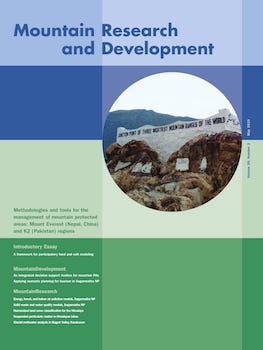The problem of supporting decision- and policy-makers in managing issues related to solid waste and water quality was addressed within the context of a participatory modeling framework in the Sagarmatha National Park and Buffer Zone in Nepal. We present the main findings of management-oriented research projects conducted within this framework, thus providing an overview of the current situation in the park regarding solid waste and water quality issues. We found that most of the solid waste generated in the park is composed of organic matter, paper, and minor reused waste that is mainly reused for cattle feeding and manure, while disposal of other nondegradable categories of collected waste (glass, metal, and plastic) is not properly managed. Particularly, burning or disposal in open dumps poses a great hazard to environmental, human, and animal health, as most dump sites situated close to water courses are prone to regular flooding during the rainy season, thereby directly contaminating river water. Pollutants and microbiological contamination in water bodies were found and anthropogenic activities and hazardous practices such as solid waste dump sites, open defecation, and poor conditions of existing septic tanks are suggested as possibly affecting water quality. Collection of these data on solid waste and water quality and compilation of management information on the targeted social-ecological system allowed us to develop consensus-building models to be used as management supporting tools. By implementing such models, we were able to simulate scenarios identifying and evaluating possible management solutions and interventions in the park. This work reveals insights into general dynamics that can support the quest for solutions to waste and water quality management problems in other protected areas and mountain landscapes where traditional livelihood and land use patterns are changing under the influence of a growing population, changing consumption patterns, and international tourism.
How to translate text using browser tools
1 May 2010
Solid Waste and Water Quality Management Models for Sagarmatha National Park and Buffer Zone, Nepal
Emanuela Chiara Manfredi,
Bastian Flury,
Gaetano Viviano,
Sudeep Thakuri,
Sanjay Nath Khanal,
Pramod Kumar Jha,
Ramesh Kumar Maskey,
Rijan Bhakta Kayastha,
Kumud Raj Kafle,
Silu Bhochhibhoya,
Narayan Prasad Ghimire,
Bharat Babu Shrestha,
Gyanendra Chaudhary,
Francesco Giannino,
Fabrizio Cartenì,
Stefano Mazzoleni,
Franco Salerno

Mountain Research and Development
Vol. 30 • No. 2
May 2010
Vol. 30 • No. 2
May 2010
Nepal
Participatory modeling
Sagarmatha National Park and Buffer Zone
solid waste management
system dynamics
water pollution
water quality




